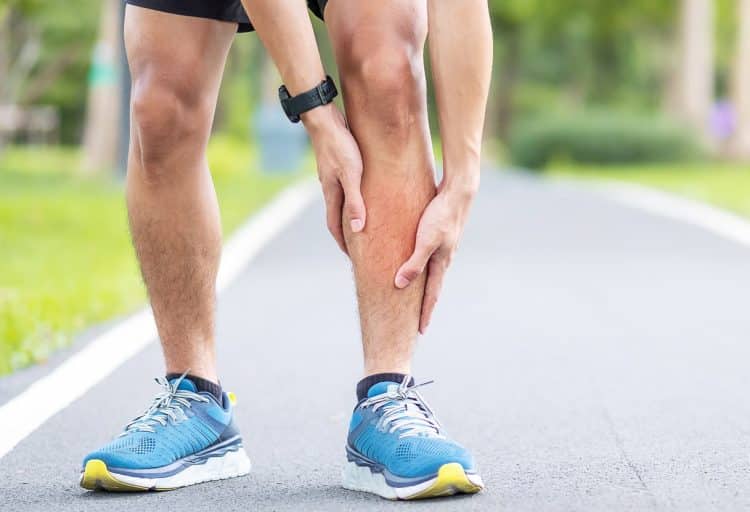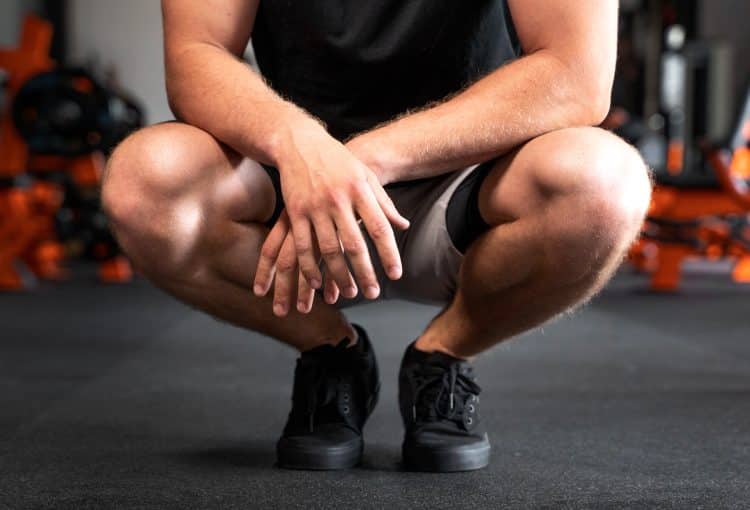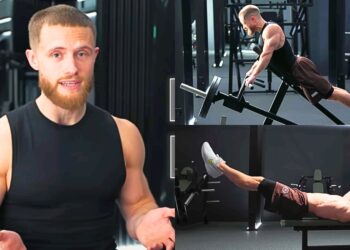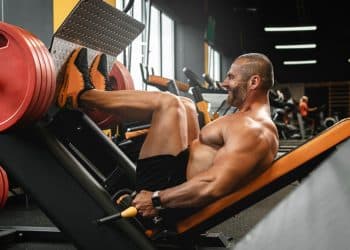Do you experience sudden sharp or throbbing frontal lower leg pain after running? Are you wondering why your shin area is particularly sensitive to touch? There’s a good chance it is due to medial tibial stress syndrome (MTSS).
The review paper “Overuse injuries: tendinopathies, stress fractures, compartment syndrome, and shin splints” confirmed that shin splints are one of the most common overuse injuries and that approximately 50% of all sports injuries stem from repetitive microtrauma. (1)
As a strength and conditioning coach with five years in the trenches, I encounter people dealing with shin splints weekly. I’ve seen countless cases resolved and prevented simply through targeted exercises and stretches.
In this article, I’ll discuss ways to prevent the occurrence of this tedious syndrome, and should it arise, the same exercises and stretches prove beneficial.
Understanding Shin Splints

Although ‘shin splints’ is a broad medical term encompassing various lower leg conditions, in 90% of instances, it specifically refers to medial tibial stress syndrome (MTSS).
Level Up Your Fitness: Join our 💪 strong community in Fitness Volt Newsletter. Get daily inspiration, expert-backed workouts, nutrition tips, the latest in strength sports, and the support you need to reach your goals. Subscribe for free!
Lower leg anatomy is complex, but in this case, you have to know about three muscles — tibialis anterior, tibialis posterior, and soleus. Microdamage of those muscles, tendons that attach them to bones, and surrounding tissue over time leads to inflammation.
Inflammation and subsequent pain in the area of the tibia (shin bone) are called shin splints.
Pain (especially after running or brisk walking) along the inner edge of the shinbone is the main symptom, yet tenderness, and mild swelling are typical indicators too.
Although it can be very painful, it certainly does not belong to the group of most severe sports injuries like ACL or Achilles tear. Unlike those injuries, shin splints can be treated with conservative treatments, and the recovery period is incomparably shorter.
8 Exercises for Shin Splints
The following exercises stand out as top choices for alleviating shin splints, as they offer a combination of minimal strain on the shins and maximum therapeutic benefits:
Calf Raises
Calf raises are a staple exercise in most lower-body workouts. This exercise is equally useful for addressing shin splints and Achilles problems or as part of a regular leg day.
Stronger calves will absorb a significant part of the load when you run, thus relieving the shinbone.
There are several variations of this exercise. You can do it standing, sitting, with or without weights, and as you progress, add single-leg calf raises to your workout.
How to:
- Stand with feet hip-width apart.
- Lift your heels off the ground, rising on the toes and upper part of the feet.
- Hold the raised position for a few seconds.
- Slowly lower your heels back down to the ground.
Pro tip: I always remind my clients to avoid rapid or jerky movements and maintain full control throughout the entire exercise; otherwise, it is useless.
Ankle Dorsiflexion with Resistance Band
Ankle dorsiflexion exercise targets an often overlooked muscle — tibialis anterior. That muscle is the primary dorsiflexor (pulls the ankle and foot back toward your shin), and this exercise is the perfect way to strengthen it.
How to:
- Sit on the floor with your legs extended.
- Wrap the resistance band around a sturdy anchor.
- Tie the other end around the top of your foot.
- Flex your ankle, pulling your toes towards your shin against the resistance.
- Slowly return to the starting position.
Pro tip: Once you strengthen the muscles around the shinbone, you can do this exercise with a kettlebell, either standing or sitting. Thread your foot through a kettlebell’s handle and do the same movement.
Toe Walk
The toe walk is a simple yet effective way to engage the lower leg muscles.
This gentle yet effective low-impact exercise engages the muscles along the shin, offering a meaningful challenge without subjecting them to undue stress. It is suitable even for the first phase of shin split recovery.
How to:
- Stand on your toes and the balls of your feet.
- Walk for a set distance or time.
- Maintain an upright posture throughout the exercise.
Pro tip: Do this exercise barefoot for better foot muscle engagement. Weak feet are often a hidden cause of lower body problems.
Heel Walk
The heel walk exercise complements the toe walk by targeting different muscles in the lower legs. Walking on your heels will activate muscles on both sides of the lower leg.
Another advantage of this exercise is improved ankle mobility. Many people have poor ankle mobility due to low-quality shoes and other factors like poor walking patterns.
How to:
- Lift your toes off the ground and stand on your heels.
- Walk forward in this heel-walking position.
- To avert lower back pain, ensure your footsteps are gentle.
Pro tip: Focus on lifting your toes as high as possible while walking on your heels.
Soleus Wall Squat
Soleus wall squat is also known as “walk squat calf raises” and “soleus wall holds.”
Whatever the name, it must be part of every runner’s workout routine. Soleus wall squat will help you improve quad and calf muscle (primarily soleus and gastrocnemius muscles) strength and endurance. The study “Muscle contributions to propulsion and support during running” proved the importance of those three muscles for running. (2)
How to:
- Stand with your back against a wall.
- Take a few steps forward, keeping your feet hip-width apart and your back against the wall.
- Lower your body into a squat, sliding down the wall.
- Get on your toes.
- Hold the squat position on your toes for a set amount of time or repetitions.
Pro tip: This is a challenging exercise, so start with shorter durations and gradually increase the time as your strength improves.
Side-Lying Adduction
You may wonder why an adductor strengthening exercise is on this list. The chances of shin splints recurring are high if you only strengthen your calves and ignore your upper legs.
This exercise isolates the adductor muscles, and exercisers of various fitness levels can perform it. That’s why it’s a perfect option for improving hip stability, addressing muscle imbalances, or preventing and rehabilitating injuries, such as shin splints.
How to:
- Lie on your side with your legs extended straight.
- Place one leg on top of the other, keeping your body straight.
- Lift the leg toward the ceiling, engaging the adductor muscle.
- Squeeze the inner thigh muscles at the top of the movement.
- Slowly return the leg to the starting position.
Pro tip: Standing banded adduction and a clamshell are great alternatives to include in your routine.
Single-Leg Glute Bridge
We must ensure our core and glutes can withstand everyday demands, or our lower legs will suffer.
Glute bridge is exactly what we need, and I prefer the unilateral variation because we all naturally have muscle imbalances and weaknesses.
How to:
- Lie on your back with your knees bent and feet flat on the ground.
- Lift one leg off the ground.
- Push through the other foot’s heel to lift your hips towards the ceiling.
- Hold the raised position for a moment.
- Lower your hips back down.
Pro tip: Try to hold the position for at least 3 seconds. This will significantly increase muscle activation and help those with dormant (sleeping) butt syndrome.
Step-ups
Step-ups are a dynamic exercise that engages the whole leg. Start with a smaller platform and move to a bigger one as you gain more experience. If you start with a platform that is too high, the pain may intensify.
Most rehab experts advise leading with the painful leg. Nevertheless, it is essential to involve the opposite leg as well. This prevents the situation where you recover from shin splints on one side only to face a similar problem on the other side.
How to:
- Stand in front of a step, platform, or box.
- Step onto it with one foot.
- Extend your leading leg to lift your other leg off the floor.
- Bring the knee towards your chest.
- Step back down and repeat on the other leg.
Pro tip: Instead of finishing with both feet flat on the box, do a calf raise before getting down.
Stretching — A Necessary Part of the Recovery/Prevention Routine
You shouldn’t use passive stretching for every type of musculoskeletal pain, but stretching is very valuable in the context of shin splints.
Do these four stretches daily, along with the exercises listed above, to speed up recovery.
Wall Calf Stretch
Keep things simple — standing calf stretch is stretching 101 for the muscles in the calves and lower leg, plus the Achilles tendon and the plantar fascia.
It is also great for enhancing ankle flexibility and mobility, which is crucial for overall lower limb function.
How to:
- Stand facing a wall, with one foot forward.
- Keep the back leg straight, heel on the ground.
- Bend the front knee so the upper and lower leg are almost at 90 degrees.
- Lean forward, feeling the stretch in the calf muscle of the rear leg.
- Hold for 15-30 seconds and switch legs.
Quad Stretch
Tight quads can lead to biomechanical imbalances that may cause or increase shin splints. Quad stretch is a perfect way to address that issue.
There are many ways to stretch the quad, but this is the simplest.
Level Up Your Fitness: Join our 💪 strong community in Fitness Volt Newsletter. Get daily inspiration, expert-backed workouts, nutrition tips, the latest in strength sports, and the support you need to reach your goals. Subscribe for free!
How to:
- Stand with feet hip-width apart.
- Bend one knee and bring your heel toward your butt.
- Grab your ankle with the corresponding hand.
- Ensure your standing leg remains slightly bent.
- Hold for the recommended time.
Towel Stretch
Towel stretch targets hamstrings, quadriceps, and calves simultaneously. You can modify the towel’s position to focus on one muscle group. It is a form of both passive and dynamic stretching.
How to:
- Sit on the floor with your legs extended.
- Loop a towel around the foot.
- Gently pull the towel towards you.
Hamstring Wall Stretch
There are two reasons why you must do the hamstring wall stretch. The first reason is that hamstrings are very susceptible to injuries, and recovery is tricky. Also, hamstrings are part of the posterior chain, and without a strong and well-stretched posterior chain, your lower limbs will not function properly.
How to:
- Lie on your back close to a wall.
- Extend your legs upwards, placing your heels against the wall.
- Flex your feet and slowly slide your heels down the wall.
- Stop when you feel a stretch in your hamstrings.
- Hold the position.
Advanced Rehabilitation Methods
My two favorite rehab methods are eccentric training and isometric exercises. If you are not familiar with these terms, let me explain.
You can do exercises for shin splints in isometric and/or eccentric mode. Gradually increasing the intensity and complexity of eccentric and isometric exercises leads to a systematic adaptation of the muscles and connective tissues.
Isometric
Isometric exercises are about static muscle contractions, where the muscle stays the same length throughout the exercise. Let’s take an isometric calf raise as an example. You get on your toes, and your muscles work hard to maintain the hold, but there’s no actual movement.
These static exercises effectively stabilize and strengthen the muscles around the shin. Holding a static calf raise position or performing wall sits will enhance muscular endurance and stability.
Eccentric
The lifting part of the exercise, where you raise the weight, is the concentric phase. It is the eccentric phase when you’re bringing the weight back down.
Engaging your muscles against resistance (eccentrics) is equally, if not more, effective than the concentric phase. Eccentric exercises for the lower leg, such as slowly lowering the heel during calf raises, place controlled stress on the muscles, strengthening them without aggravating pain.
Eccentric training is especially important for athletes during rehabilitation, whether shin splints or something else.
Tips For Managing Pain
The pain won’t subside instantly, even with regular exercise and daily stretching.
That’s why I will give you a few more tips to help you manage pain and avoid planning your entire schedule around shin splints.
Over-the-Counter (OTC) Medicines
Non-prescription pain relievers like ibuprofen or naproxen can help alleviate discomfort.
In addition to acute pain reduction, they will also have a positive effect on the treatment of inflammation because they belong to the group of non-steroidal anti-inflammatory drugs (NSAIDs).
Of course, you must follow the recommended dosage and consult a doctor if you have any pre-existing conditions or concerns about potential side effects.
RICE Method
For decades, the RICE protocol (Rest, Ice, Compression, Elevation) has been the primary way of treating almost all injuries.
Applying ice will lessen swelling and pain, and leg compression sleeves will reduce inflammation. Resting and elevating the leg is crucial for recovery and promoting fluid drainage.
Massage and Foam Rolling
Massage can significantly contribute to the recovery process. It should be a gentle massage to improve blood flow and reduce muscle tension, not to worsen pain.
If you don’t have access to an experienced massage therapist, try self-massage and foam rolling. Using a foam roller, focus on moving back and forth over the calves, shins, and surrounding muscles. Use a softer foam roller, especially the first few days. Some foam rollers are too hard and can cause discomfort.
Shin Split Prevention
You know what they say: “Prevention is better than cure,” and that is 100% true for shin splints, as they are preventable in most cases.
The aforementioned exercises and stretches are the go-to choice for prevention, but that’s not all. Even with a proper lower leg strength routine and avoiding frequent long runs, symptoms of shin splints can still arise.
Proper Footwear
Footwear is often the main culprit behind shin splints, Achilles tendinopathy, plantar fasciitis, and other similar issues. Believe me, I have first-hand experience of this.
Remember, worn-out shoes are terrible for your whole body. Regularly replace training shoes.
Opt for shoes that provide adequate arch support and cushioning to absorb impact during running or walking. The footwear should also offer stability to prevent overpronation, a common cause of shin splints.
Correct Running and Walking Posture
Each individual possesses a unique and distinct walking and running style. If you have recently had an injury, chances are that you have unconsciously changed your movement pattern to avoid pain.
Record yourself running or hire a personal trainer to analyze your movement patterns. This way, you can improve yourself and prevent possible injuries. Also, avoid overstriding, as it can lead to increased impact on the shins.
Nutrition
I’m sure nutrition is not the first thing that comes to your mind when treating shin splits. Nevertheless, nutrition is a fundamental aspect of overall fitness and can contribute to preventing shin splints.
You have to eat a balanced diet full of macronutrients from healthy sources. On top of that, calcium and vitamin D supplementation is crucial for bone health, which can directly affect shin splints.
Do not forget to drink plenty of water. Dehydration can affect muscle function and increase the risk of injuries.
Kinesiology Tape
The popularity of kinesiology tape has grown immensely in recent years. You could see Novak Djokovic wearing it at the last Australian Open because of a hamstring strain or James Harden because of a shoulder injury.
In theory, it can stabilize the lower leg muscles, helping with shin splints. However, the study featured in The Physician and Sportsmedicine Journal revealed that the efficacy of KT on shin splints is not clear and called for more research (3). Although it will not harm you, the benefits remain questionable.
FAQs
How to distinguish regular muscle soreness from shin splints?
Regular muscle soreness is general discomfort in the muscles, while shin splints specifically involve pain along the shinbone. If the pain is concentrated along the inner edge of the shin, worsens during or after exercise, and is accompanied by tenderness to the touch, it is probably shin splints rather than usual muscle soreness.
What is the typical recovery time for shin splints?
As with any injury, it is impossible to accurately predict recovery, but typical recovery time ranges from several weeks to a few months. Adequate rest, therapy, and exercise can expedite healing. Individual factors such as age, overall health, and physical fitness also affect the time required for complete recovery.
Can I ignore shin splints and continue physical activity without interruption?
No, ignoring shin splints and continuing physical activity will only worsen things, leading to prolonged recovery, potential complications, and chronic problems. Rest is essential for healing, in combination with a modified exercise routine that includes lower-impact activities.
Which lower leg issues can be confused with shin splints due to the similarity in their symptoms?
Stress fractures, compartment syndrome, calf strain, and fibrous dysplasia, among others, share symptoms with shin splints, causing diagnosis confusion. An accurate diagnosis is of utmost importance since almost all other potential issues are much more dangerous than shin splints and can leave long-term consequences.
Wrapping Up
You’ve just run a half marathon, you feel like you’re in perfect shape, and then shin splints suddenly derail you. I feel for you because injuries have hindered me more than once, but this is not the moment to despair.
Let’s focus on the bright side. In 99% of cases, shin splints treatment does not include surgery or any other invasive method. All you need to do is rest and regularly perform the exercises and stretches listed in this article, and you will be back in no time!
And once you recover, don’t forget about prevention. Otherwise, the problem may become recurring.
If the situation does not improve or you suspect another injury, talk with your doctor or physiotherapist.
References
- Wilder RP, Sethi S. Overuse injuries: tendinopathies, stress fractures, compartment syndrome, and shin splints. Clin Sports Med. 2004 Jan;23(1):55-81, vi. doi: 10.1016/S0278-5919(03)00085-1. PMID: 15062584.
- Hamner SR, Seth A, Delp SL. Muscle contributions to propulsion and support during running. J Biomech. 2010 Oct 19;43(14):2709-16. doi: 10.1016/j.jbiomech.2010.06.025. Epub 2010 Aug 9. PMID: 20691972; PMCID: PMC2973845.
- Guo S, Liu P, Feng B, Xu Y, Wang Y. Efficacy of kinesiology taping on the management of shin splints: a systematic review. Phys Sportsmed. 2022 Oct;50(5):369-377. doi: 10.1080/00913847.2021.1949253. Epub 2021 Jul 19. PMID: 34176444.
Article Updates Timeline:
Our editorial team experts constantly update the articles with new information & research, ensuring you always have access to the latest and most reliable information.
January 17, 2024
Written By
Filip Maric, PT
Reviewed By
Vidur Saini
Fact Checked By
Dr. Malik










